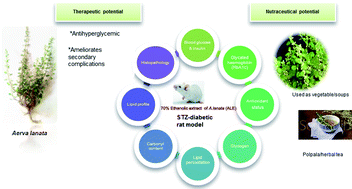Nutraceutical potential of Aerva lanata (L.) Juss. ex Schult ameliorates secondary complications in streptozotocin-induced diabetic rats†
Abstract
Nutraceuticals provide health benefits beyond their basic nutrition by modulating a number of biochemical pathways. They are derived from natural products and have gained recognition worldwide as an adjuvant or therapy in the treatment of metabolic disorders such as diabetes. Although the regulation of blood glucose with drugs and insulin greatly reduces the incidence of secondary complications, the need for long-term treatment raises issues of tolerance and affordability. Therefore, the aim of the present study is to explore the nutraceutical potential of Aerva lanata, a herb widely used for its culinary and therapeutic potential in streptozotocin (STZ)-induced diabetic rats. Treatment with 70% ethanolic extract (ALE) at 500 mg per kg b.w per day for 21 days significantly improved the fasting blood glucose (120.33 ± 1.99 mg dL−1), insulin level (9.81 ± 0.38 mU L−1), HbA1c (7.3 ± 0.36%) and glycogen content in the liver (35.33 ± 1.38 mg g−1 protein) and muscle (7.67 ± 0.11 mg g−1 protein) compared to diabetic controls. The extract also showed a significant decrease in blood glucose by 47.29% towards the end of 2 h in oral glucose tolerance test on Day 21. Its therapeutic potential could be partly attributable to the presence of flavonoids, tannins and terpenes (alpha amyrin, betulin and beta sitosterol) along with micronutrients such as potassium, magnesium, calcium and zinc. Hence, we suggest the suitability of Aerva lanata as a nutraceutical for diabetic patients.


 Please wait while we load your content...
Please wait while we load your content...